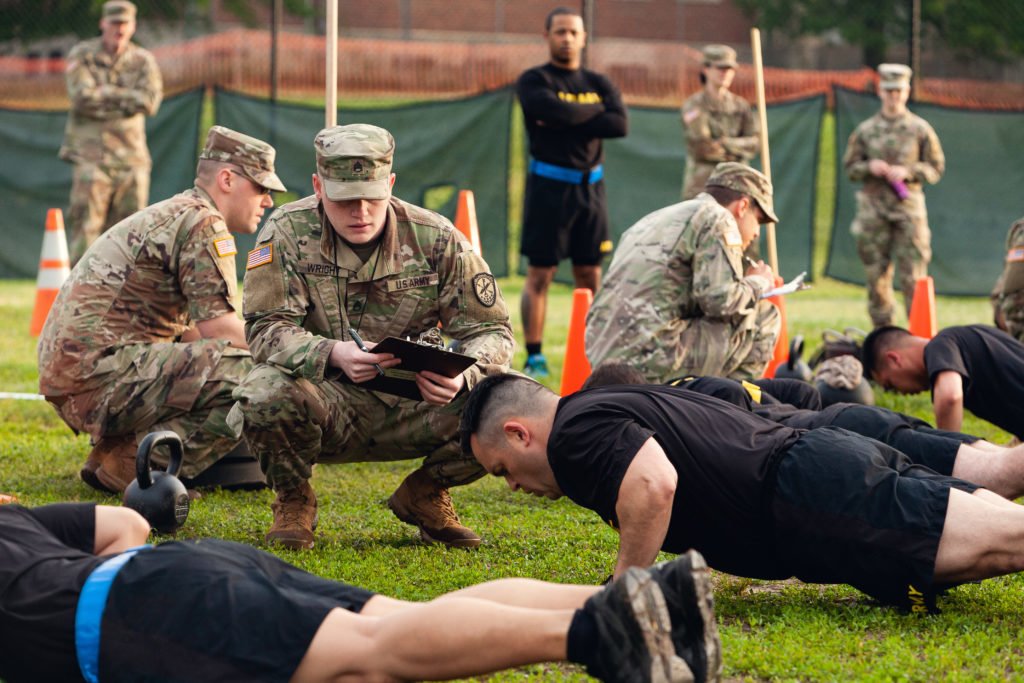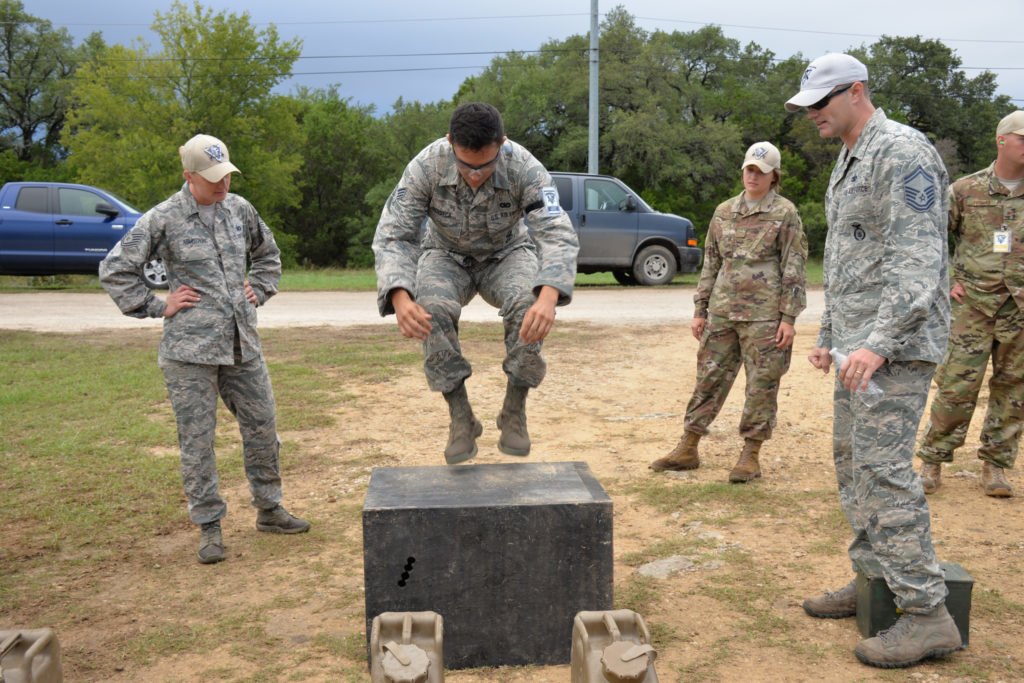
U.S. Army Staff Sgt. Gregory Kozloski, a military policeman assigned to the 107th Military Policy Company, 104th Military Police Battalion, 369th Sustainment Brigade, New York Army National Guard (NYARNG) performs deadlifts as a part of the Army Combat Fitness Test during the 53rd Troop Command Best Warrior Competition at Camp Smith Training Site, N.Y., February 21, 2020. The 53rd Troop Command Best Warrior Competition is an annual event in which junior enlisted Soldiers and non-commissioned officers from various 53rd Troop Command units compete in several events intended to test their military skills and knowledge, as well as their physical fitness and endurance with the winners proceeding the State competition in March. (U.S. Army National Guard photo by Sgt. Jonathan Pietrantoni)
Change is often met with resistance, and the Army Combat Fitness Test (ACFT) is no different. When it was announced last year that it would replace the Army Physical Fitness Test (APFT), it was met with criticism and concerns, as well as some support and reserved optimism.
In one corner you have the traditionalist, posing questions about implementation, injury, lack of gender and age delineation, along with leaked data regarding failure rates in test battalions.
In the other corner are the knuckle-dragging meatheads, excited to demonstrate their prowess by going “extended” scale on the 3RM deadlift, while mean muggin’ their brethren about being weak.
Of course, there is a middle ground, which was a common theme in my research. If you start training for “it” you will get better at “it” — whatever that “it” may be.

Regardless, the APFT’s 39-year run has come to an end, the ACFT is here, and, to use common phraseology, we need to drive on. The best approach for doing so is to be incrementally progressive.
Let’s first add a little context — I’m looking at the ACFT through the lens of accessibility. Do the troops have access to the tools to train for the ACFT? One potential drawback of the ACFT is that it is more equipment-dominant than the APFT. Good for equipment manufacturers, maybe not so good for the deployed soldier or approximately 600,000 reserve-component soldiers.
The following training model uses three or four pieces of equipment and addresses the two areas that seem to be the most challenging — the leg tuck and power throw — while keeping space usage to a minimum. Additionally, we’re not going to discuss the two exercises that are currently in the APFT, the push-up and the 2-mile run — after 39 years or so, we’ve probably got those down.
Exercise 1: Straight from the ACFT, Leg Tuck x 5 reps

If you cannot do five reps, modify to an amount that you can — even one or two reps is a fine place to start. If you cannot do one leg tuck, I would probably dial this section into 20 to 30 seconds of timed hanging. Although this will impact your ability to progress the program at some point, it will help address the issue of grip strength, which is likely the linchpin for many on this exercise.
Exercise 2: Double Kettlebell Sprinter Stance Deadlift x 2/2 reps
The beauty of this drill is that there are always some mismatched kettlebells laying around. The cool thing about using the kettlebells is that the larger grip diameter allows us to carry over some of the grip training we need for the leg tuck. By using the sprinter stance body position, you don’t need as much weight to get a training effect.
Without reclassing to 36B mathematical wizard, here’s an example of how it works: let’s say you can scrounge up a 100-pound and a 80-pound kettlebell, for a total of 180 pounds. That’s passing even by the heavy standard, but we need to account for most of the work being done unilaterally.
Here’s how: Approximately 75 percent of the load is on your forward leg.
180 pounds x .75 (75 percent) = 135 pounds of work on your dominant working leg. That equates to a total of 270 pounds of bilateral capacity, putting you at approximately 88 percent of max for a bilateral lift like the hex bar deadlift.
So while we might sacrifice purely chasing load, we are getting secondary benefits of additional grip strength training and core training due to the more dynamic nature of the kettlebell.
Could you do this exercise with dumbbells? Yes, you just need to be cognizant of the range of motion difference between kettlebells and dumbbells.
Exercise 3: Power Box Jumps x 3 reps

Note: This drill is meant to replace the power throw. Using a box jump mimics the power output and movement pattern of the power throw without requiring huge amounts of space or having to go and “shag” a medicine ball after every throw.
All you really need is one of the three-side boxes commonly found in many FOB gyms. They are usually built to have 20-, 24-, and 30-inch increments. Select a height that is challenging, yet not going to cause you to “burn in” your shins on the edge of the box.
Exercise 4: Do something hard x 30 seconds

If you have equipment available, use it — I’ve used a bike and jump rope for this exercise. You could certainly use a treadmill. If you don’t have any equipment, burpees would be a good pain option. The exercise you choose should be taxing enough to mimic the stress you are sure to encounter during the sprint-drag-carry event. Whatever you choose, make sure you are attempting to produce consistent output each round, i.e. counting, reps, speed, or rpms.
So, let’s put this accessibility sandwich together: Do five to 10 rounds of all four exercises in sequence. The number of rounds is dependent on your fitness level. Log your time, and aim to improve it every time your do this workout. Instead of rounds, you can also do the workout for time. If this style of training is new to you, give yourself a couple of iterations of practice before putting yourself on the clock. By training for time, you’ll be accounting for the significant reduction in time allotted to complete the ACFT.
The best way to implement this workout would be to insert it as one day in your weekly training regimen. While it is almost infinitely progressive, I suggest keeping it in your program for four to eight weeks.
My goal here was to remove as many of the hesitations, reservations, and roadblocks to training for the ACFT as possible by providing a program and equipment list that can be utilized in a 63-square-foot B-hut room or could be found on any FOB or picked up on Craigslist.

Troy Anderson is a farm kid from rural Wyoming, current National Guard soldier, and co-owner of functional training facility Farm Strong Fit Gym. He has spent 15 years in the fitness industry becoming a subject-matter expert, international presenter, and internationally published metabolism researcher. Troy’s mission is to spread the good word of the ACCESSIBILITY and VALUE of kettlebells, sandbags, and bodyweight training.
BRCC and Bad Moon Print Press team up for an exclusive, limited-edition T-shirt design!
BRCC partners with Team Room Design for an exclusive T-shirt release!
Thirty Seconds Out has partnered with BRCC for an exclusive shirt design invoking the God of Winter.
Lucas O'Hara of Grizzly Forge has teamed up with BRCC for a badass, exclusive Shirt Club T-shirt design featuring his most popular knife and tiomahawk.
Coffee or Die sits down with one of the graphic designers behind Black Rifle Coffee's signature look and vibe.
Biden will award the Medal of Honor to a Vietnam War Army helicopter pilot who risked his life to save a reconnaissance team from almost certain death.
Ever wonder how much Jack Mandaville would f*ck sh*t up if he went back in time? The American Revolution didn't even see him coming.
A nearly 200-year-old West Point time capsule that at first appeared to yield little more than dust contains hidden treasure, the US Military Academy said.












